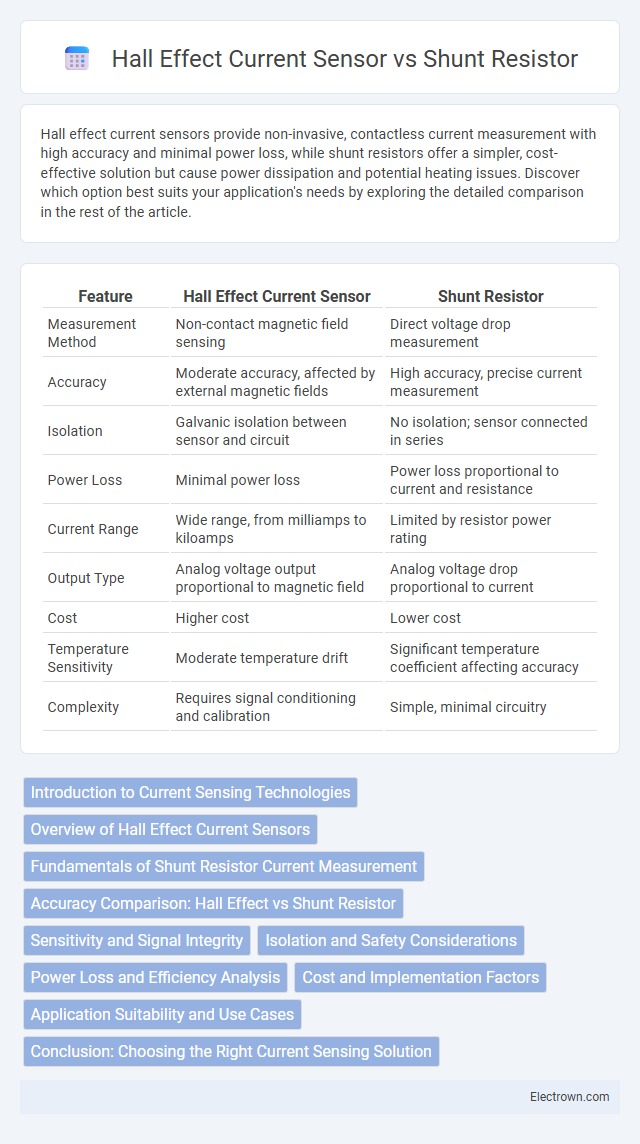Hall effect current sensors provide non-invasive, contactless current measurement with high accuracy and minimal power loss, while shunt resistors offer a simpler, cost-effective solution but cause power dissipation and potential heating issues. Discover which option best suits your application's needs by exploring the detailed comparison in the rest of the article.
Table of Comparison
| Feature | Hall Effect Current Sensor | Shunt Resistor |
|---|---|---|
| Measurement Method | Non-contact magnetic field sensing | Direct voltage drop measurement |
| Accuracy | Moderate accuracy, affected by external magnetic fields | High accuracy, precise current measurement |
| Isolation | Galvanic isolation between sensor and circuit | No isolation; sensor connected in series |
| Power Loss | Minimal power loss | Power loss proportional to current and resistance |
| Current Range | Wide range, from milliamps to kiloamps | Limited by resistor power rating |
| Output Type | Analog voltage output proportional to magnetic field | Analog voltage drop proportional to current |
| Cost | Higher cost | Lower cost |
| Temperature Sensitivity | Moderate temperature drift | Significant temperature coefficient affecting accuracy |
| Complexity | Requires signal conditioning and calibration | Simple, minimal circuitry |
Introduction to Current Sensing Technologies
Hall effect current sensors provide non-intrusive, contactless measurement by detecting magnetic fields generated by current flow, enabling galvanic isolation and minimizing power loss. Shunt resistors measure current through voltage drop across a known resistance, offering high accuracy and straightforward integration but introducing power dissipation and potential heat generation. Both technologies are fundamental in current sensing applications, with selection guided by factors like required isolation, measurement range, accuracy, and system design constraints.
Overview of Hall Effect Current Sensors
Hall Effect current sensors utilize the Hall effect principle to measure magnetic fields generated by current-carrying conductors, offering non-intrusive and isolated current measurement. These sensors provide high accuracy, wide bandwidth, and can measure both AC and DC currents without direct electrical contact, unlike shunt resistors that rely on voltage drop measurement. Hall Effect sensors enable safer, more reliable current monitoring in applications such as power supplies, motor control, and energy management systems.
Fundamentals of Shunt Resistor Current Measurement
Shunt resistor current measurement relies on Ohm's law, where the current flowing through the resistor creates a proportional voltage drop that can be accurately measured. This method involves placing a low-value resistor in series with the load, allowing precise sensing of current by monitoring the voltage across the resistor. Your system's accuracy depends on the resistor's tolerance, temperature coefficient, and power rating, making proper selection crucial for reliable current measurement.
Accuracy Comparison: Hall Effect vs Shunt Resistor
Hall effect current sensors provide high accuracy in measuring DC and low-frequency AC currents due to their non-contact magnetic field detection, minimizing disturbance to the circuit. Shunt resistors offer precise current measurement with less noise at high frequencies but introduce power loss and heat dissipation, which can affect long-term reliability. Overall, Hall effect sensors excel in isolation and signal integrity, while shunt resistors deliver superior linearity and resolution under stable thermal conditions.
Sensitivity and Signal Integrity
Hall effect current sensors offer higher sensitivity by detecting magnetic fields generated by current flow without direct electrical contact, thus providing isolation and minimizing signal distortion. Shunt resistors measure current by voltage drop, which can introduce thermal noise and power loss, impacting signal integrity under high current conditions. Hall sensors maintain better signal integrity in noisy environments, making them preferable for precise current measurements requiring isolation and high accuracy.
Isolation and Safety Considerations
Hall effect current sensors provide galvanic isolation, enhancing safety by electrically separating the measurement circuit from high-voltage lines, preventing potential shock hazards and equipment damage. Shunt resistors, lacking inherent isolation, require additional isolation components or careful PCB design to ensure user safety and protect sensitive electronics from high voltages. The isolation offered by Hall effect sensors is crucial in applications involving high-current or high-voltage environments, where electrical isolation improves overall system reliability and operator safety.
Power Loss and Efficiency Analysis
Hall effect current sensors minimize power loss by operating without direct electrical contact, enabling higher efficiency in measurement applications compared to shunt resistors, which introduce resistive power dissipation proportional to current flow. Shunt resistors cause a voltage drop and generate heat, reducing overall system efficiency, especially in high-current scenarios. Choosing a Hall effect sensor can enhance your system's energy efficiency by eliminating resistive losses intrinsic to shunt resistor designs.
Cost and Implementation Factors
Hall effect current sensors typically cost more than shunt resistors due to their complex semiconductor components and packaging, but they enable non-intrusive current measurement without direct electrical contact. Implementation of Hall effect sensors is simpler in high-current or isolation-required applications since they do not introduce a voltage drop or dissipate power like shunt resistors, which require careful thermal management and precise placement in the circuit. Your choice depends on whether cost constraints or ease of integration and system safety are higher priorities in your design.
Application Suitability and Use Cases
Hall effect current sensors excel in applications requiring galvanic isolation and non-intrusive measurements, making them ideal for monitoring high-voltage systems and electric vehicles. Shunt resistors are better suited for low-voltage, high-accuracy current sensing in tightly controlled environments such as power supplies and battery management systems. Your choice depends on the need for electrical isolation, measurement range, and accuracy requirements in specific use cases.
Conclusion: Choosing the Right Current Sensing Solution
Hall effect current sensors offer non-intrusive, galvanically isolated measurements ideal for high-voltage or AC current applications, while shunt resistors provide precise, low-cost, and compact solutions suitable for DC currents with minimal voltage drop. Selecting the right current sensing method depends on factors like accuracy requirements, system voltage, isolation needs, and thermal management. For applications demanding isolation and safety, Hall effect sensors are preferred, whereas shunt resistors excel in cost-sensitive, low-voltage environments where direct measurement is feasible.
hall effect current sensor vs shunt resistor Infographic

 electrown.com
electrown.com